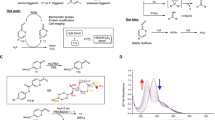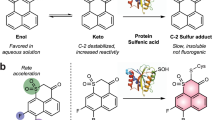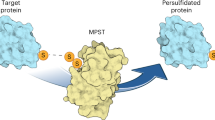Abstract
The chemical species involved in H2S signaling remain elusive despite the profound and pleiotropic physiological effects elicited by this molecule. The dominant candidate mechanism for sulfide signaling is persulfidation of target proteins. However, the relatively poor reactivity of H2S toward oxidized thiols, such as disulfides, the low concentration of disulfides in the reducing milieu of the cell and the low steady-state concentration of H2S raise questions about the plausibility of persulfide formation via reaction between an oxidized thiol and a sulfide anion or a reduced thiol and oxidized hydrogen disulfide. In contrast, sulfide oxidation pathways, considered to be primarily mechanisms for disposing of excess sulfide, generate a series of reactive sulfur species, including persulfides, polysulfides and thiosulfate, that could modify target proteins. We posit that sulfide oxidation pathways mediate sulfide signaling and that sulfurtransferases ensure target specificity.
This is a preview of subscription content, access via your institution
Access options
Subscribe to this journal
Receive 12 print issues and online access
$259.00 per year
only $21.58 per issue
Buy this article
- Purchase on Springer Link
- Instant access to full article PDF
Prices may be subject to local taxes which are calculated during checkout






Similar content being viewed by others
References
Russell, M.J. & Hall, A.J. The emergence of life from iron monosulphide bubbles at a submarine hydrothermal redox and pH front. J. Geol. Soc. Lond. 154, 377–402 (1997).
Wacey, D., Kilburn, M.R., Saunders, M., Cliff, J. & Brasier, M.D. Microfossils of sulphur-metabolizing cells in 3.4-billion-year-old rocks of Western Australia. Nat. Geosci. 4, 698–702 (2011).
Anbar, A.D. & Knoll, A.H. Proterozoic ocean chemistry and evolution: a bioinorganic bridge? Science 297, 1137–1142 (2002).
Li, C. et al. A stratified redox model for the Ediacaran ocean. Science 328, 80–83 (2010).
Grice, K. et al. Photic zone euxinia during the Permian-Triassic superanoxic event. Science 307, 706–709 (2005).
Klotz, M.G., Bryant, D.A. & Hanson, T.E. The microbial sulfur cycle. Front. Microbiol. 2, 241 (2011).
Giles, G.I. & Jacob, C. Reactive sulfur species: an emerging concept in oxidative stress. Biol. Chem. 383, 375–388 (2002).
Gruhlke, M.C. & Slusarenko, A.J. The biology of reactive sulfur species (RSS). Plant Physiol. Biochem. 59, 98–107 (2012).
Li, Q. & Lancaster, J.R. Jr. Chemical foundations of hydrogen sulfide biology. Nitric Oxide 35, 21–34 (2013).
Paulsen, C.E. & Carroll, K.S. Cysteine-mediated redox signaling: chemistry, biology, and tools for discovery. Chem. Rev. 113, 4633–4679 (2013).
Kabil, O., Motl, N. & Banerjee, R. H2S and its role in redox signaling. Biochim. Biophys. Acta 1844, 1355–1366 (2014).
Hildebrandt, T.M. & Grieshaber, M.K. Three enzymatic activities catalyze the oxidation of sulfide to thiosulfate in mammalian and invertebrate mitochondria. FEBS J. 275, 3352–3361 (2008).
Vitvitsky, V., Yadav, P.K., Kurthen, A. & Banerjee, R. Sulfide oxidation by a noncanonical pathway in red blood cells generates thiosulfate and polysulfides. J. Biol. Chem. 290, 8310–8320 (2015).
Mathai, J.C. et al. No facilitator required for membrane transport of hydrogen sulfide. Proc. Natl. Acad. Sci. USA 106, 16633–16638 (2009).
Riahi, S. & Rowley, C.N. Why can hydrogen sulfide permeate cell membranes? J. Am. Chem. Soc. 136, 15111–15113 (2014).
Chen, K.Y. & Morris, J.C. Kinetics of oxidation of aqueous sulfide by O2 . Environ. Sci. Technol. 6, 529–537 (1972).
Vitvitsky, V., Kabil, O. & Banerjee, R. High turnover rates for hydrogen sulfide allow for rapid regulation of its tissue concentrations. Antioxid. Redox Signal. 17, 22–31 (2012).
O'Brien, D.J. & Birkner, F.B. Kinetics of oxygenation of reduced sulfur species in aqueous solution. Environ. Sci. Technol. 11, 1114–1120 (1977).
Carballal, S. et al. Reactivity of hydrogen sulfide with peroxynitrite and other oxidants of biological interest. Free Radic. Biol. Med. 50, 196–205 (2011).
Millis, K.K., Weaver, K.H. & Rabenstein, D.L. Oxidation/reduction potential of glutathione. J. Org. Chem. 58, 4144–4146 (1993).
Furne, J., Saeed, A. & Levitt, M.D. Whole tissue hydrogen sulfide concentrations are orders of magnitude lower than presently accepted values. Am. J. Physiol. Regul. Integr. Comp. Physiol. 295, R1479–R1485 (2008).
Vitvitsky, V. et al. Perturbations in homocysteine-linked redox homeostasis in a murine model for hyperhomocysteinemia. Am. J. Physiol. Regul. Integr. Comp. Physiol. 287, R39–R46 (2004).
Das, T.N., Huie, R.E., Neta, P. & Padmaja, S. Reduction potential of the sulfhydryl radical: pulse radiolysis and laser flash photolysis studies of the formation and reactions of SH and HSSH− in aqueous solutions. J. Phys. Chem. A 103, 5221–5226 (1999).
Kraus, D.W., Wittenberg, J.B., Jing-Fen, L. & Peisach, J. Hemoglobins of the Lucina pectinata/bacterial symbiosis. I. Molecular properties, kinetics and equilibria of reactions with ligands. J. Biol. Chem. 265, 16054–16059 (1990).
Flores, J.F. et al. Sulfide binding is mediated by zinc ions discovered in the crystal structure of a hydrothermal vent tubeworm hemoglobin. Proc. Natl. Acad. Sci. USA 102, 2713–2718 (2005).
Pietri, R. et al. Factors controlling the reactivity of hydrogen sulfide with hemeproteins. Biochemistry 48, 4881–4894 (2009).
Keilin, D. On the combination of methaemoglobin with H2S. Proc. R. Soc. Lond., B 113, 393–404 (1933).
Chatfield, M.J., La Mar, G.N. & Kauten, R.J. Proton NMR characterization of isomeric sulfmyoglobins: preparation, interconversion, reactivity patterns, and structural features. Biochemistry 26, 6939–6950 (1987).
Nicholls, P. & Kim, J.K. Sulphide as an inhibitor and electron donor for the cytochrome c oxidase system. Can. J. Biochem. 60, 613–623 (1982).
Pavlik, J.W., Noll, B.C., Oliver, A.G., Schulz, C.E. & Scheidt, W.R. Hydrosulfide (HS−) coordination in iron porphyrinates. Inorg. Chem. 49, 1017–1026 (2010).
Brittain, T., Yosaatmadja, Y. & Henty, K. The interaction of human neuroglobin with hydrogen sulphide. IUBMB Life 60, 135–138 (2008).
Poulos, T.L. Soluble guanylate cyclase. Curr. Opin. Struct. Biol. 16, 736–743 (2006).
Cavallini, D., Federici, G. & Barboni, E. Interaction of proteins with sulfide. Eur. J. Biochem. 14, 169–174 (1970).
Massey, V. & Edmondson, D. On the mechanism of inactivation of xanthine oxidase by cyanide. J. Biol. Chem. 245, 6595–6598 (1970).
Branzoli, U. & Massey, V. Evidence for an active site persulfide residue in rabbit liver aldehyde oxidase. J. Biol. Chem. 249, 4346–4349 (1974).
Huber, R. et al. A structure-based catalytic mechanism for the xanthine oxidase family of molybdenum enzymes. Proc. Natl. Acad. Sci. USA 93, 8846–8851 (1996).
Gutteridge, S., Tanner, S.J. & Bray, R.C. Comparison of the molybdenum centres of native and desulpho xanthine oxidase. The nature of the cyanide-labile sulphur atom and the nature of the proton-accepting group. Biochem. J. 175, 887–897 (1978).
Brondino, C.D., Romao, M.J., Moura, I. & Moura, J.J. Molybdenum and tungsten enzymes: the xanthine oxidase family. Curr. Opin. Chem. Biol. 10, 109–114 (2006).
de Beus, M.D., Chung, J. & Colon, W. Modification of cysteine 111 in Cu/Zn superoxide dismutase results in altered spectroscopic and biophysical properties. Protein Sci. 13, 1347–1355 (2004).
Valentine, W.N., Toohey, J.I., Paglia, D.E., Nakatani, M. & Brockway, R.A. Modification of erythrocyte enzyme activities by persulfides and methanethiol: possible regulatory role. Proc. Natl. Acad. Sci. USA 84, 1394–1398 (1987).
Krishnan, N., Fu, C., Pappin, D.J. & Tonks, N.K. H2S-induced sulfhydration of the phosphatase PTP1B and its role in the endoplasmic reticulum stress response. Sci. Signal. 4, ra86 (2011).
Mustafa, A.K. et al. H2S signals through protein S-sulfhydration. Sci. Signal. 2, ra72 (2009).
Vandiver, M.S. et al. Sulfhydration mediates neuroprotective actions of parkin. Nat. Commun. 4, 1626 (2013).
Weerapana, E. et al. Quantitative reactivity profiling predicts functional cysteines in proteomes. Nature 468, 790–795 (2010).
Finkel, T. From sulfenylation to sulfhydration: what a thiolate needs to tolerate. Sci. Signal. 5, pe10 (2012).
Kabil, O. & Banerjee, R. The redox biochemistry of hydrogen sulfide. J. Biol. Chem. 285, 21903–21907 (2010).
Libiad, M., Yadav, P.K., Vitvitsky, V., Martinov, M. & Banerjee, R. Organization of the human mitochondrial H2S oxidation pathway. J. Biol. Chem. 289, 30901–30910 (2014).
Yadav, P.K., Yamada, K., Chiku, T., Koutmos, M. & Banerjee, R. Structure and kinetic analysis of H2S production by human mercaptopyruvate sulfurtransferase. J. Biol. Chem. 288, 20002–20013 (2013).
Pestaña, A. & Sols, A. Reversible inactivation by elemental sulfur and mercurials of rat liver serine dehydratase and certain sulfhydryl enzymes. Biochem. Biophys. Res. Commun. 39, 522–529 (1970).
Kato, A., Ogura, M. & Suda, M. Control mechanism in the rat liver enzyme system converting L-methionine to L-cystine. 3. Noncompetitive inhibition of cystathionine synthetase-serine dehydratase by elemental sulfur and competitive inhibition of cystathionase-homoserine dehydratase by L-cysteine and L-cystine. J. Biochem. 59, 40–48 (1966).
Toohey, J.I. Sulfhydryl dependence in primary explant hematopoietic cells. Inhibition of growth in vitro with vitamin B12 compounds. Proc. Natl. Acad. Sci. USA 72, 73–77 (1975).
Greiner, R. et al. Polysulfides link H2S to protein thiol oxidation. Antioxid. Redox Signal. 19, 1749–1765 (2013).
Kimura, Y. et al. Polysulfides are possible H2S-derived signaling molecules in rat brain. FASEB J. 27, 2451–2457 (2013).
Marcia, M., Ermler, U., Peng, G. & Michel, H. The structure of Aquifex aeolicus sulfide:quinone oxidoreductase, a basis to understand sulfide detoxification and respiration. Proc. Natl. Acad. Sci. USA 106, 9625–9630 (2009).
King, A.L. et al. Hydrogen sulfide cytoprotective signaling is endothelial nitric oxide synthase–nitric oxide dependent. Proc. Natl. Acad. Sci. USA 111, 3182–3187 (2014).
Koike, S., Ogasawara, Y., Shibuya, N., Kimura, H. & Ishii, K. Polysulfide exerts a protective effect against cytotoxicity caused by t-buthylhydroperoxide through Nrf2 signaling in neuroblastoma cells. FEBS Lett. 587, 3548–3555 (2013).
Mueller, E.G. Trafficking in persulfides: delivering sulfur in biosynthetic pathways. Nat. Chem. Biol. 2, 185–194 (2006).
Francoleon, N.E., Carrington, S.J. & Fukuto, J.M. The reaction of H2S with oxidized thiols: generation of persulfides and implications to H2S biology. Arch. Biochem. Biophys. 516, 146–153 (2011).
Ono, K. et al. Redox chemistry and chemical biology of HS, hydropersulfides, and derived species: implications of their possible biological activity and utility. Free Radic. Biol. Med. 77, 82–94 (2014).
Ida, T. et al. Reactive cysteine persulfides and S-polythiolation regulate oxidative stress and redox signaling. Proc. Natl. Acad. Sci. USA 111, 7606–7611 (2014).
Bordo, D. & Bork, P. The rhodanese/Cdc25 phosphatase superfamily. Sequence-structure-function relations. EMBO Rep. 3, 741–746 (2002).
Palenchar, P.M., Buck, C.J., Cheng, H., Larson, T.J. & Mueller, E.G. Evidence that ThiI, an enzyme shared between thiamin and 4-thiouridine biosynthesis, may be a sulfurtransferase that proceeds through a persulfide intermediate. J. Biol. Chem. 275, 8283–8286 (2000).
Matthies, A., Nimtz, M. & Leimkuhler, S. Molybdenum cofactor biosynthesis in humans: identification of a persulfide group in the rhodanese-like domain of MOCS3 by mass spectrometry. Biochemistry 44, 7912–7920 (2005).
Noma, A., Sakaguchi, Y. & Suzuki, T. Mechanistic characterization of the sulfur-relay system for eukaryotic 2-thiouridine biogenesis at tRNA wobble positions. Nucleic Acids Res. 37, 1335–1352 (2009).
Ikeuchi, Y., Shigi, N., Kato, J., Nishimura, A. & Suzuki, T. Mechanistic insights into sulfur relay by multiple sulfur mediators involved in thiouridine biosynthesis at tRNA wobble positions. Mol. Cell 21, 97–108 (2006).
Nagahara, N., Yoshii, T., Abe, Y. & Matsumura, T. Thioredoxin-dependent enzymatic activation of mercaptopyruvate sulfurtransferase. An intersubunit disulfide bond serves as a redox switch for activation. J. Biol. Chem. 282, 1561–1569 (2007).
Melideo, S.L., Jackson, M.R. & Jorns, M.S. Biosynthesis of a central intermediate in hydrogen sulfide metabolism by a novel human sulfurtransferase and its yeast ortholog. Biochemistry 53, 4739–4753 (2014).
Jackson, M.R., Melideo, S.L. & Jorns, M.S. Human sulfide:quinone oxidoreductase catalyzes the first step in hydrogen sulfide metabolism and produces a sulfane sulfur metabolite. Biochemistry 51, 6804–6815 (2012).
Agrò, A.F., Mavelli, I., Cannella, C. & Federici, G. Activation of porcine heart mitochondrial malate dehydrogenase by zero valence sulfur and rhodanese. Biochem. Biophys. Res. Commun. 68, 553–560 (1976).
Theissen, U. & Martin, W. Sulfide: quinone oxidoreductase (SQR) from the lugworm Arenicola marina shows cyanide- and thioredoxin-dependent activity. FEBS J. 275, 1131–1139 (2008).
Goubern, M., Andriamihaja, M., Nubel, T., Blachier, F. & Bouillaud, F. Sulfide, the first inorganic substrate for human cells. FASEB J. 21, 1699–1706 (2007).
Kabil, O. & Banerjee, R. Characterization of patient mutations in human persulfide dioxygenase (ETHE1) involved in H2S catabolism. J. Biol. Chem. 287, 44561–44567 (2012).
Krussel, L. et al. The mitochondrial sulfur dioxygenase ETHYLMALONIC ENCEPHALOPATHY PROTEIN1 is required for amino acid catabolism during carbohydrate starvation and embryo development in Arabidopsis. Plant Physiol. 165, 92–104 (2014).
Álvarez, C., Garcia, I., Romero, L.C. & Gotor, C. Mitochondrial sulfide detoxification requires a functional isoform O-acetylserine(thiol)lyase C in Arabidopsis thaliana. Mol. Plant 5, 1217–1226 (2012).
Marcia, M., Ermler, U., Peng, G. & Michel, H. A new structure-based classification of sulfide:quinone oxidoreductases. Proteins 78, 1073–1083 (2010).
Sakaguchi, M. et al. Sodium thiosulfate attenuates acute lung injury in mice. Anesthesiology 121, 1248–1257 (2014).
Snijder, P.M. et al. Exogenous administration of thiosulfate, a donor of hydrogen sulfide, attenuates Angiotensin II-induced hypertensive heart disease in rats. Br. J. Pharmacol. 172, 1494–1504 (2015).
Liu, L.J. et al. Thiosulfate transfer mediated by DsrE/TusA homologs from acidothermophilic sulfur-oxidizing archaeon Metallosphaera cuprina. J. Biol. Chem. 289, 26949–26959 (2014).
Ranguelova, K. et al. Sulfite-mediated oxidation of myeloperoxidase to a free radical: immuno-spin trapping detection in human neutrophils. Free Radic. Biol. Med. 60, 98–106 (2013).
Togawa, T. et al. High performance liquid chromatographic determination of bound sulfide and sulfite and thiosulfate at their low levels in human serum by pre-column fluorescence derivatization with monobromobimane. Chem. Pharm. Bull. (Tokyo) 40, 3000–3004 (1992).
Gunnison, A.F. & Jacobsen, D.W. Sulfite hypersensitivity. A critical review. CRC Crit. Rev. Toxicol. 17, 185–214 (1987).
Yarmolinsky, D., Brychkova, G., Fluhr, R. & Sagi, M. Sulfite reductase protects plants against sulfite toxicity. Plant Physiol. 161, 725–743 (2013).
Crane, B.R., Siegel, L.M. & Getzoff, E.D. Sulfite reductase structure at 1.6 A: evolution and catalysis for reduction of inorganic anions. Science 270, 59–67 (1995).
Holmström, K.M. & Finkel, T. Cellular mechanisms and physiological consequences of redox-dependent signalling. Nat. Rev. Mol. Cell Biol. 15, 411–421 (2014).
West, A.P. et al. TLR signalling augments macrophage bactericidal activity through mitochondrial ROS. Nature 472, 476–480 (2011).
Zhou, R., Yazdi, A.S., Menu, P. & Tschopp, J. A role for mitochondria in NLRP3 inflammasome activation. Nature 469, 221–225 (2011).
Pan, Y., Schroeder, E.A., Ocampo, A., Barrientos, A. & Shadel, G.S. Regulation of yeast chronological life span by TORC1 via adaptive mitochondrial ROS signaling. Cell Metab. 13, 668–678 (2011).
Mailloux, R.J. & Harper, M.E. Mitochondrial proticity and ROS signaling: lessons from the uncoupling proteins. Trends Endocrinol. Metab. 23, 451–458 (2012).
Sörbo, B. On the formation of thiosulfate from inorganic sulfide by liver tissue and heme compounds. Biochim. Biophys. Acta 27, 324–329 (1958).
Baxter, C.F. & Van Reen, R. The oxidation of sulfide to thiosulfate by metalloprotein complexes and by ferritin. Biochim. Biophys. Acta 28, 573–578 (1958).
Smith, R.P. & Gosselin, R.E. On the mechanism of sulfide inactivation by methemoglobin. Toxicol. Appl. Pharmacol. 8, 159–172 (1966).
Valentine, W.N. & Frankenfeld, J.K. 3-Mercaptopyruvate sulfurtransferase (EC 2.8.1.2): a simple assay adapted to human blood cells. Clin. Chim. Acta 51, 205–210 (1974).
Nicholls, P. & Kim, J.K. Oxidation of sulphide by cytochrome aa3. Biochim. Biophys. Acta 637, 312–320 (1981).
Collman, J.P., Ghosh, S., Dey, A. & Decreau, R.A. Using a functional enzyme model to understand the chemistry behind hydrogen sulfide induced hibernation. Proc. Natl. Acad. Sci. USA 106, 22090–22095 (2009).
Pálinkás, Z. et al. Interactions of hydrogen sulfide with myeloperoxidase. Br. J. Pharmacol. 172, 1516–1532 (2015).
Nakamura, S., Nakamura, M., Yamazaki, I. & Morrison, M. Reactions of ferryl lactoperoxidase (compound II) with sulfide and sulfhydryl compounds. J. Biol. Chem. 259, 7080–7085 (1984).
Searcy, D.G., Whitehead, J.P. & Maroney, M.J. Interaction of Cu,Zn superoxide dismutase with hydrogen sulfide. Arch. Biochem. Biophys. 318, 251–263 (1995).
Bucci, M. et al. Hydrogen sulfide is an endogenous inhibitor of phosphodiesterase activity. Arterioscler. Thromb. Vasc. Biol. 30, 1998–2004 (2010).
Bucci, M. et al. cGMP-dependent protein kinase contributes to hydrogen sulfide-stimulated vasorelaxation. PLoS ONE 7, e53319 (2012).
Acknowledgements
This work was supported in part by the US National Institutes of Health (GM112455 and HL58984).
Author information
Authors and Affiliations
Corresponding author
Ethics declarations
Competing interests
The authors declare no competing financial interests.
Rights and permissions
About this article
Cite this article
Mishanina, T., Libiad, M. & Banerjee, R. Biogenesis of reactive sulfur species for signaling by hydrogen sulfide oxidation pathways. Nat Chem Biol 11, 457–464 (2015). https://doi.org/10.1038/nchembio.1834
Received:
Accepted:
Published:
Issue Date:
DOI: https://doi.org/10.1038/nchembio.1834
This article is cited by
-
Hydrogen sulfide and polysulfides induce GABA/glutamate/d-serine release, facilitate hippocampal LTP, and regulate behavioral hyperactivity
Scientific Reports (2023)
-
Discovery of a cystathionine γ-lyase (CSE) selective inhibitor targeting active-site pyridoxal 5′-phosphate (PLP) via Schiff base formation
Scientific Reports (2023)
-
Enzyme-independent catabolism of cysteine with pyridoxal-5′-phosphate
Scientific Reports (2023)
-
Structural and functional imaging of brains
Science China Chemistry (2023)
-
Ficin-copper hybrid nanoflowers with enhanced peroxidase-like activity for colorimetric detection of biothiols
Microchimica Acta (2023)



